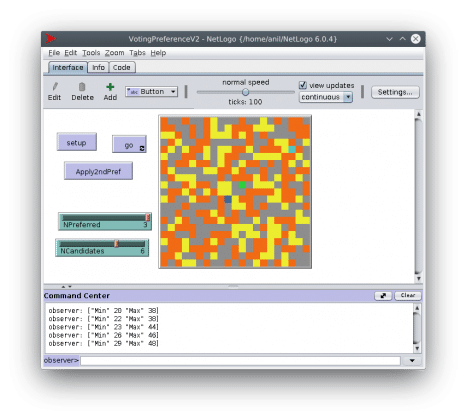
For example, use range to generate a list, and then use foreach to process.
NETLOGO FOREACH CODE
I am using exactly the same code as mentioned in the example. The foreach command iterates over a list, which may be created in all the usual ways. I tried using gis:create-turtles-inside-polygon command instead of gis:apply-coverage but when I type the command gis:create-turtles-inside it gives an error saying nothing named gis:create-turtles-inside has been defined. (sqrt 3)) rt 120 fd 20 (2 / (sqrt 3)) die let keys table:keys path-table foreach keys let path table:get path-table draw-line.
NETLOGO FOREACH HOW TO
I am not sure how to add a number of turtles per postcode according to NUM_TURTLES field from the postcode shapefile. This process seems quite complicated, but the principle comes from the basics connect. We then use another two foreach functions to grab the endpoints of road links, and use create-link-with to connect the links.

NETLOGO FOREACH PATCH
Let uniquepostcodelist remove-duplicates postcodelistĪsk one-of respatches with ] One the first line, we call the GIS file road imported as a patch variable, and use foreach to select the property of each road link. Gis:apply-coverage res_town "POA" postcodeĪsk patches ] NaN fix The foreach command takes two inputs, a list and a parameterized block. Gis:set-coverage-minimum-threshold 0.0000001 NetLogo provides seven commands for iteratively (repeatedly) executing a block. What replaces the for command used for example in R in NetLogo language Could it be foreach Loop types in NetLogo, we can use the following commands. Gis:set-world-envelope (gis:envelope-union-of (gis:envelope-of res_town) (gis:envelope-of studyextent) ) Resize-world -924 924 -800 800 0 gis:width-of (studyextent) - 1 0 gis:height-of (studyextent) - 1

Set studyextent gis:load-dataset "Projected_data/Apr.asc" Set res_town gis:load-dataset "Projected_data/town_data.shp" The following code can successfully create one turtle per postcode. I could create one turtle within each postcode boundary but struggling to figureout how can I create number of turtles within each postcode boundary according to the NUM_AGENT field from the attribute table of postcode shapefile? I have imported the postcode shapefile in NetLogo and applied postcodes to the patches. (Note: If you are already familiar with StarLogo or StarLogoT, then the material in the first four sections may already be familiar to you.) The Code Example models mentioned throughout can be found in the Code Examples section of the Models. The foreach command is a loop which will iterate over. The following material explains some important features of programming in NetLogo. Of course, that may not be so easy to implement in your real model.I am trying to create turtles within postcode boundary. Then, as long as the patch-data list exists, it will read in each sublist using the foreach command. However, a better way to do this is with the map procedure instead of foreach because all the values are changed at once rather than looping through the list and dealing with each.


The procedure change-interpretation2 is the way to implement your approach, replacing each item and creating the new list (addressing the problems identified). The procedure change-intention1 is the way you are currently thinking about it (my interpretation anyway). The code is self contained - open a new model and try it out, changing the call in the testme procedure to different implementations. The second is that you can't use set to do that, you have to use replace-item. The Modeling Commons contains more than 2000 other NetLogo models, contributed by modelers around the world. Another workaround is to run NetLogo with an option recommended by Oracle, by editing the NetLogo 6.2.2.vmoptions file, found in the NetLogo directory (under Program Files on your hard drive, unless you installed NetLogo in a different location). It takes as inputs the list and a block of commands, e.g.: foreach 2 4 6 crt show (word 'created ' ' turtles') > created 2 turtles > created 4 turtles > created 6 turtles map is similar to foreach, but it is a reporter (it returns a list). processing model, written by Anthony Dekker. not empty feasibleheadings foreach feasibleheadings move-to patch-here let headingtoask. foreach is used to run a block of commands on each item in a list. foreach examples (1) foreach - run a command or commands on each item in a. The first is that lists are not mutable - if you want to change the value in a list, you have to create a new list with that value. This page was automatically generated by NetLogo 5.0.


 0 kommentar(er)
0 kommentar(er)
